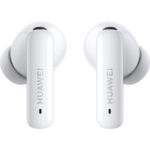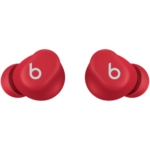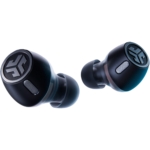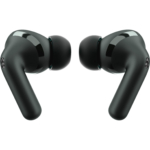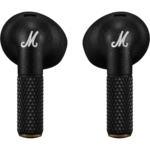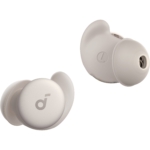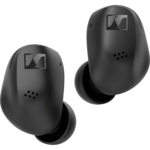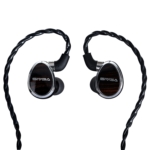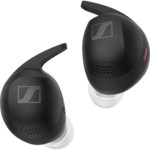The JBL Reflect Aero True Wireless in-ears are stable-fitting headphones that impressed us with their high-quality IP68 protection class and the versatile adjustment options available via the app. Thanks to good sound and functional ambient noise control, these sports earphones are also highly suitable for everyday use. The JBL Reflect Aero’s weak points are their somewhat low total runtime and a rather poor phone call quality when used in windy conditions or with background noise.
- secure fit
- IP68 dust and waterproof earpieces
- ambient noise control
- individual sound and headphone adjustment via app
- Google Assistant and Alexa integration (Android devices only)
- supports multipoint connections
- reduced-latency video mode
- limited speech intelligibility in windy conditions and ambient noise
- background noise in transparency and TalkThru mode
- handset without charge indicator
JBL’s Reflect Aero range of wireless in-ears for sports enthusiasts feature dustproof and waterproof construction, powerful tuning and the option to attenuate or amplify ambient noise as required. Extensive earpiece and sound settings can also be made via the app.
The Reflect Aero are available in white, black, mint or blue and come with three sizes of ear tips and silicone wings (Powerfins), which can be used in any combination. Once you have found a suitable arrangement, simply twist the in-ears twisted into the ear; this ensures a firm, stable fit that can even withstand stronger vibrations. These earphones are ideally equipped for sports and outdoor use thanks to their dustproof and waterproof design, which conforms to IP68. This also facilitates cleaning and care of the system, as, for example, salt water or sweat residues can be rinsed off directly after use. These sports earphones also fit under a winter hat if it is not too tight, as the housings do not protrude too far.
Battery life
At higher volumes, the Reflect Aero can achieve six hours and 20 minutes of listening time in basic mode, and this is reduced to five hours and 10 minutes when Adaptive Noise Cancellation is used. These in-ears can be fully recharged twice in the case before an external power source is needed. This results in a total runtime of 19 hours in standard mode or up to fifteen and a half hours in ANC mode, which is just about sufficient but not by much. During our test, we noticed that these in-ears need to be placed in the charging case with a certain amount of care. Unfortunately, since there is no charge indicator, it is not immediately apparent whether or not the earphones are actually being charged. However, when the case is drawing power via the USB-C port, the LED goes out after 110 minutes to signal that the battery reserve has been restored.
Operation
Pairing the JBL Reflect Aero, which supports Bluetooth standard 5.2 and multipoint connections with two devices at the same time, is done by opening the charging case. This turns the system on and automatically puts it into pairing mode, while placing the earpieces back in the charging case turns the system off. For Android devices, it is also possible to make a quick connection via Google Fast Pair. Manual switching on and off via the touch-sensitive headphones surfaces is not provided, but automatic switch-off in case of inactivity can be configured via the app. The assignment of touch controls can be adjusted within predefined settings via the app. Playback can be controlled, and you can skip forward and backwards and switch between ANC and ambient mode. There is also direct access to the TalkThru function for communication with other people and voice control. Siri is available for the iPhone and iPad, and Alexa or Google Assistant can be integrated with Android devices. In addition to touch control, these sports earphones are also equipped with wearer recognition so that playback pauses automatically when the earphones are taken out, and this can be deactivated via the app.
Audio and video mode
As for audio codecs, the JBL Reflect Aero support Bluetooth standard SBC and the higher-quality AAC format. Two optimisations are also available via the app with the audio and video modes, with the Audio Mode aiming to provide increased sound quality. In Video Mode, latency is reduced, and this improves the synchronicity of picture and sound when gaming or watching films. This is nicely done as these optimisations have hardly any effect on the stability of the wireless connection. While indoors, several rooms can be covered, outdoors, there is a range of up to 20 metres.
Speech intelligibility during phone calls
According to the manufacturer, the Reflect Aero have three beamforming microphones on each side, which ensure clear and distinct transmission of one’s own voice. However, this only works in a quiet environment, as wind and background noise are not noticeably attenuated and dull the call quality.
App connectivity
The JBL Headphones app (Android and iOS) offers versatile personalisation options, such as an EQ section for custom sound settings that can be saved. In addition, there are five ready-made presets to choose from: “Jazz”, “Vocal”, “Bass”, “Club”, and “Studio”. Another central feature is ambient noise control: Both the Reflect Aero’s transparency mode and the noise cancellation are adjustable through seven intensity levels. An adaptive ANC mode is also available, and this automatically adjusts to the environment. Headphone settings such as a monitoring function (VoiceAware) for telephone calls can also be configured in three gain levels, allowing you to achieve a more natural conversation situation. In addition, these in-ears have multi-lingual voice prompts, which can be switched on or off, while a fit test checks the fit. The app can also help you find the earpieces by activating a loud beep. There is also the option to make firmware updates.
How good are the ANC, Ambient and TalkThru modes of the JBL Reflect Aero?
In Transparency mode (Ambient Aware), there was an underlying noise that increased from level to level and could affect playback in the upper settings. However, the amplification of external sounds was clean and loud so that even the middle levels were sufficient to be responsive during playback and allow you to perceive your surroundings. In addition, in TalkThru mode, which automatically lowers the playback level, a conversation could be held without any problems, even if there was more noise.
The JBL Reflect Aero’s noise cancellation worked silently and attenuated the low-frequency range quite significantly, while the upper-frequency spectrum was only slightly filtered. The adjustable ANC mode in its maximum setting and the Adaptive Noise Cancelling were at a comparable level. However, the effect could be increased if the ear canal compensation was active and if an ear canal test had been previously completed with the help of the app. This required a very loud environment, which seemed somewhat problematic. Subsequently, however, the noise suppression succeeded in fading out deep sources of interference over a broad range and effectively attenuated background voices so that they were hardly perceptible when listening to music. Only high-frequency noises still got through, but they were also reduced.
The sound of the JBL Reflect Aero
The full, warm basic sound of the JBL Reflect Aero had a rich, powerful bass response that only held back a little in the lowest regions so it always sounded controlled and powerful. This means that the Reflect Aero are good for use during sports and provides listening pleasure across all genres. But if you prefer a more powerful low bass, you can easily boost it with the EQ. Conversely, a slight reduction in the mid-bass range led to an even more balanced presentation. The midrange was also assertive enough for mobile use but did not neglect the more subtle qualities so that details could be discovered effortlessly in a quiet, relaxed atmosphere, for example, when listening while sitting on the sofa. This made for a successful bridging of the gap, making these sports headphones a versatile tool, especially as vocal reproduction was well-intelligible. In addition, the upper registers were reproduced with verve, setting desired accents without overshooting the mark. Sibilants were reproduced rather meekly, but this reinforced the good-natured basic character of the slightly bass-emphasised tuning.
Technical specifications
- Ear couplingIn-ear
- Typeclosed
- Transducer principledynamic
- Frequency response (headphones)20 - 20.000 Hz
- Impedance16 ohms
- Sound pressure level (SPL)@1 kHz / 1 mW: 99 dB
- Weight without cable6.5g each, case 13 g
What's in the box
- Eartips & powerfins in 3 sizes each (S, M, L)
- USB-C to USB-A charging cable
- Charging case
Special features
- Available in white, black, mint or blue
- BT codecs: SBC, AAC
- BT version: 5.2
- BT profiles: A2DP V1.3, AVRCP V1.6, HFP V1.8










